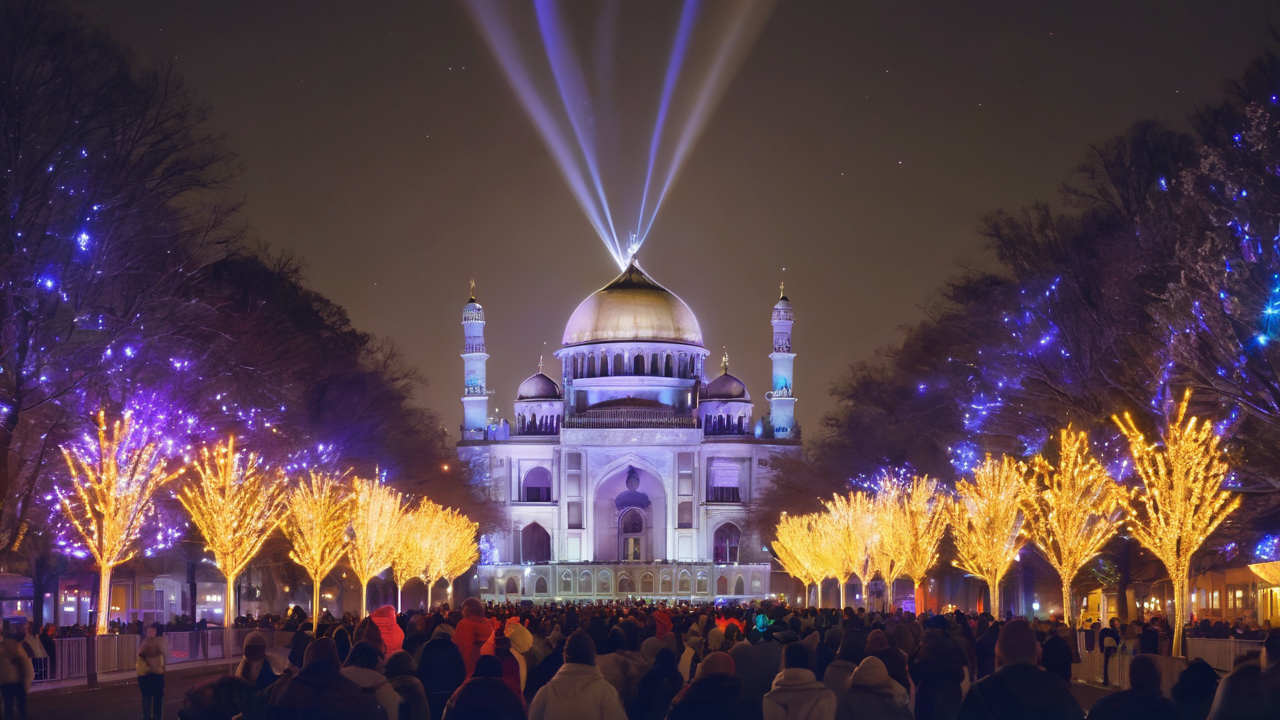Illuminate your understanding of one of the world’s most radiant celebrations with our deep dive into the history and origins of the Festival of Lights. This article traces the cultural roots of this dazzling event, exploring how traditions have evolved over time and the role that modern technology, such as video mapping and projection mapping, has played in transforming the festival into a spectacular spectacle of light art. From the ancient beginnings of the Festival of Lights to the cutting-edge video projection techniques used in today’s Light Fests, this exploration provides an enlightening perspective on this beloved global phenomenon.
Tracing the cultural roots of the Festival of Lights
The Festival of Lights, also known as the Light Fest, is a significant event that brings to life the magic and beauty of light art through video mapping and projection mapping techniques. As we trace the cultural roots of the Festival of Lights, it becomes clear that this event is more than just a spectacle of visual effects and video projection. It’s a celebration deeply rooted in history and varies in meaning across different cultures.
In India, the Festival of Lights is known as Diwali, a Hindu festival that signifies the victory of light over darkness and good over evil. It involves lighting oil lamps, decorating homes with colorful rangoli artworks, and setting off fireworks. The video mapping and projection mapping techniques used in modern celebrations add a new dimension to this ancient festival.
In Lyon, France, the Festival of Lights or “Fête des Lumières” takes place in early December. This event has a religious origin, tracing back to 1852 when the city’s inhabitants lit their windows with candles to honor the Virgin Mary. Today, the festival has evolved into a four-day event that features stunning light art installations, video projections, and performances across the city.
Meanwhile, in Thailand, the Festival of Lights known as “Loi Krathong” is celebrated by releasing floating lanterns onto the river, symbolizing the letting go of all one’s hatred, anger, and defilements. While traditional lanterns are still used, modern celebrations have incorporated elaborate light installations and video mapping to enhance the visual spectacle.
In Jewish culture, the Festival of Lights, or Hanukkah, commemorates the rededication of the Second Temple in Jerusalem. The eight-day festival involves the lighting of the menorah, with each day representing a miracle where one day’s worth of oil lasted eight days. Today, public menorah lightings often involve creative light art and video projections to celebrate the festival in a contemporary way.
Regardless of its cultural context, the Festival of Lights universally represents hope, joy, and the triumph of light over darkness. Modern techniques such as video mapping and projection mapping have brought a fresh perspective to these traditional celebrations, merging culture with technology to create unforgettable events. Whether it’s the vibrant colors of Diwali, the innovative installations at Fête des Lumières, the floating lanterns of Loi Krathong, or the glowing menorahs of Hanukkah, the Festival of Lights continues to dazzle and inspire across cultures.
Understanding the Role of Video Mapping in the Festival of Lights
Video Mapping, also known as Projection Mapping, has become a pivotal aspect of the Festival of Lights in recent years. This transformative light art technology has brought a new dimension to the event, creating immersive and dynamic visual experiences.
Traditionally, the Festival of Lights, celebrated in various cultures worldwide, symbolizes the triumph of light over darkness, good over evil. The event is marked by lighting lamps, candles, and fireworks to illuminate the night. However, with the advent of modern technology and the rise of digital art forms, Video Mapping has become an integral part of this festival, adding a contemporary touch to a historical event.
Video Mapping in the Festival of Lights involves projecting video content onto buildings, structures, or any three-dimensional objects, transforming ordinary facades into spectacular displays of light and color. Artists utilize this technology to tell stories, create illusions, and bring static structures to life, enhancing the overall experience of the Festival of Lights.
One of the essential roles of Video Mapping in this event is to create a sense of community and shared experience. The Festival of Lights is not just a spectacle but an opportunity for people to connect and celebrate together. Video Mapping, with its ability to create grand, immersive displays, helps foster this sense of unity and shared celebration.
Moreover, Video Projection is not just about the visual spectacle but also about narrative and symbolism. Many artists use this technology to explore the cultural roots and historical significance of the Festival of Lights. Through their work, they seek to evoke emotions, provoke thought, and create a dialogue around the festival’s meaning and its relevance in the modern world.
In conclusion, Video Mapping has significantly enriched the Festival of Lights, adding a layer of innovation and creativity to an age-old tradition. As this light art form continues to evolve, we can look forward to even more mesmerizing displays at future Festival of Lights events.
The Evolution of Light Art in the Festival of Lights
The infusion of light art into the Festival of Lights has been a game changer, transforming this event into a vivid spectacle of creativity and innovation. The evolution of light art in the Festival of Lights is an intriguing journey that has seen an ever-growing repertoire of lighting techniques.
In the early years, the Festival of Lights relied on simple, static lighting installations to create a luminous landscape. However, as technology progressed, so did the possibilities for light art. The introduction of video projection brought a dynamic element to the festival, enabling artists to paint the night with moving images.
Video mapping, a technique where artists project video onto complex surfaces, has now become a staple in the Festival of Lights. This sophisticated light art form allows artists to transform buildings and structures into living canvases. The immersive art form has taken the festival by storm, becoming a highlight of the event.
Projection mapping, a close cousin to video mapping, also had a significant impact on the evolution of light art at the festival. This technique uses spatial mapping to project light onto irregularly shaped objects, creating 3D effects that can make buildings appear to move, change shape, or even collapse and then rebuild themselves.
The video projection technology has not just transformed the visual experience of the Festival of Lights but has also allowed for interactive installations. These installations engage audiences and create a sense of community, fostering a unique atmosphere that can only be experienced at a light fest.
The Festival of Lights has also seen the evolution of light art in the form of light sculptures. These installations, composed of LED lights, are becoming increasingly popular, offering a more tactile and immersive experience for festival-goers.
The evolution of light art in the Festival of Lights has made it more than just an event. It’s a dynamic, interactive, and immersive experience that celebrates the intersection of technology, art, and culture. As technology continues to advance, we can only anticipate the exciting and innovative directions that light art will take in future installments of the Festival of Lights.
The Impact of Projection Mapping in Modern Light Fests
Projection mapping, otherwise known as video mapping or video projection, has revolutionized modern light fests, adding a dynamic and immersive element that was previously unattainable. This cutting-edge technology allows artists to transform any surface, even irregular ones, into a vibrant display of light art. As a result, the festival of lights events have become an awe-inspiring spectacle that draws in large crowds of both locals and tourists.
The impact of projection mapping in these events extends beyond just visual appeal. It has also played a significant role in redefining public spaces and historical landmarks. During the festival of lights, buildings, monuments, and even landscapes are transformed into stunning canvases for light art, breathing new life into these structures and creating a captivating atmosphere. This has not only enhanced the aesthetic value of these locations but also encouraged a newfound appreciation for them.
Furthermore, projection mapping has revolutionized the way stories are told at these events. Video mapping enables the creation of immersive narratives that effectively captivate the audience. It brings together light, sound, and movement to create a multi-sensory experience that engages the audience on a deeper level. This storytelling approach has become increasingly popular at light fest events, facilitating cultural exchange and fostering a sense of community.
The interactive nature of projection mapping also plays a vital role in enhancing audience engagement during these events. Viewers are no longer just passive observers but can actively participate in the event, making the experience more personal and memorable. Many festival of lights events now feature interactive installations where spectators can manipulate the projected images, fostering a sense of involvement and inclusion.
In conclusion, the advent of projection mapping has significantly enhanced the visual, narrative, and interactive elements of modern light fests. It has reimagined the way light art is presented and experienced, turning the festival of lights into a captivating event that mesmerizes audiences and leaves a lasting impression.
How video projection transforms the event of festival of lights
Video projection has significantly transformed the Festival of Lights, adding a dynamic and immersive dimension to the event. The use of video mapping, also known as projection mapping, has reshaped the way we perceive and experience this annual light fest.
Projection mapping is a modern technique that manipulates light to turn irregularly shaped objects into a display surface for video projection. Anything from buildings to landscapes can be transformed into a canvas for light art. This technology has been a game-changer in the event industry, offering boundless opportunities for creativity and innovation.
The Festival of Lights has become a platform for artists to showcase their skills in video projection and light art. The transformation of architectural structures into vibrant light art pieces, through video mapping, has been a key highlight of the festival. This technology has allowed artists to create intricate, large-scale light installations that narrate stories, express themes, and engage audiences in a unique and interactive way.
The integration of video projection into the Festival of Lights has not only created visually stunning exhibits but also made the event more engaging and immersive for attendees. The interplay of light and darkness, through meticulously designed projection mapping, has created a captivating environment that transcends the traditional viewing experience.
Moreover, video projection has also expanded the possibilities for cultural expression at the Festival of Lights. By projecting images and narratives that reflect the cultural roots of the festival, artists have been able to foster a deeper connection between attendees and the event’s historical and cultural significance.
In conclusion, the use of video mapping and video projection in the Festival of Lights has elevated the event to new heights. It has transformed static structures into vibrant light art, enriched the cultural narrative of the festival, and created an immersive experience that continues to captivate audiences worldwide. Through these advancements, the Festival of Lights has become more than just an event; it is a celebration of creativity, culture, and the transformative power of light.
In conclusion, the Festival of Lights is a cultural event that has evolved significantly throughout history, transforming from an age-old tradition into a modern spectacle of light art. The cultural roots of this festival are deeply entwined with the advancement of technology, particularly in the realm of video mapping and projection mapping. These cutting-edge techniques have redefined the way the Festival of Lights is celebrated today, turning it into a vibrant Light Fest that captivates audiences worldwide. Video projection, in particular, has played a pivotal role in this transformation, adding a dynamic, immersive dimension to the event. As we continue to celebrate the Festival of Lights, it’s intriguing to trace its cultural roots and see how it has evolved over time, reflecting the remarkable intersection of tradition and technology.



